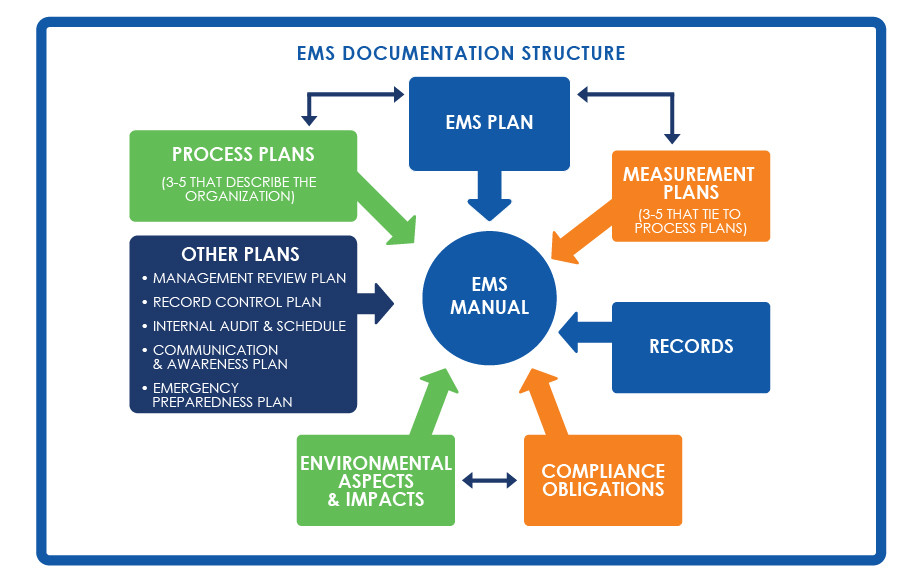What Is an Environmental Management System (EMS)? 2023 Update
EMS is a framework or set of guidelines that helps your business reach specific environmental goals. The system provides continuous review, evaluation, and improvement checkpoints to ensure an organization achieves its goals. An EMS is tailored to each company, helping you define your objectives and get to work.
For many businesses, the objective is to maintain compliance with ISO 14001 standards.

Components of EMS
In an EMS system, you will have three main components:
Core processes: The core processes include an overview of what they are and their outputs. You’ll also identify environmental impacts and aspects.
Key supporting processes: This component covers awareness of legal environmental management requirements, employee competence, communication, infrastructure for EMS, and monitoring and evaluating EMS performance.
Management system supporting operations: You will engage in document control, internal auditing, and record maintenance.
Benefits of EMS
An EMS can help reduce pollutants, emissions, and waste at your facilities. It can also help you conserve resources and maintain compliance while increasing efficiency. Other benefits an EMS can provide your business include:
- Taking a holistic approach to environmental impact.
- Using proven and trusted approaches with worldwide recognition.
- Providing a focus on the most critical processes for compliance.
- Maintaining and improving relationships with regulators.
- Increasing employees’ awareness of environmental responsibilities.

You can also receive multiple financial benefits from an EMS, such as:
- Improving your reputation and public image.
- Better reach toward new customers.
- Lower costs for environmental processes.
- Increasing profit through more effective operations.
5 Stages of an EMS Defined by ISO 14001 Standard
For an EMS to be successful, you need to cover these five stages:
1. Commitment and Policy
The people at top management levels in your enterprise need to decide that it’s time to lessen your environmental impact. They will then work to start establishing your organization’s environmental policy, which is ultimately the foundation for any EMS.
2. Planning
Next, you need to identify which of your operations contribute to negative environmental impacts such as hazardous waste or air pollution. You should determine which of these are the most significant for your company based on the criteria your organization has established.
When you have these laid out, you can start planning your objectives or broad environmental goals. You can also determine your targets, which are more specific and quantifiable.
Once you have your objectives and targets established, you will need to develop a course of action to meet them. Set schedules, designate responsibilities, and determine the necessary steps to further these goals.
3. Implementation
The implementation process is where your company deploys the appropriate resources to follow your action plan. You will likely want to train and enhance the awareness of your employees. Implementation will require you to document your progress properly, follow operating procedures, and increase communication on an internal and external level.
4. Evaluation
This straightforward stage involves your team monitoring your operations to ensure you are meeting the targets established as part of your EMS. If you find that you are not, you will need to develop a plan to take appropriate action and get back on track.
5. Review
The people in your top management positions will now review your EMS to see if it is working and determine whether your policies still align with your company’s values. If not, you can revise and regroup as many times as necessary.
How to Integrate an EMS
You’re looking for more ways to improve your business. With environmental excellence as a current focus of so many organizations, gaining ISO 14001 certification seems like a great second credential to add to your collection.
Meeting ISO guidelines ensures you will meet the standards of your customers, communities, and other stakeholders and can open you up to work with government agencies that may have more stringent requirements.

Integrated management systems (IMS) are useful for helping companies increase their focus and reduce the risks to their businesses. They require care to specify the difference between each system type (in this instance, a Quality Management System [QMS] and an EMS).
Companies will manage documentation and appoint representatives and coordinators specific to each separate management system.
Use What You Have and Adjust Your Focus
Many processes you will need to follow in order to achieve the ISO 14001 requirements for certification will already be in place as part of your QMS.
To comply with 14001, you must examine these pieces of your system and refocus them so that they address your goals and objectives related to your environmental footprint. You will need to specifically define the training you will provide to your team to educate them about your new policies and procedures. Still, the method and documentation will remain the same.

Add Environmentally-Specific Processes
Though you will use your existing system to guide the bulk of your work, ISO 14001 also requires adding new processes as you build your environmental management system. Core recommends starting with four basic elements.
Environmental Policy
Review your existing QMS policy and use it as a template to create your environmental policy. Be sure to address all the objectives and procedures that will be required to properly implement and maintain your new EMS.
Legal Requirements
Identify within your organization what legal requirements and governmental regulations apply to your business. Record how you will use your EMS to comply with the policies applicable to you, how you will maintain compliance as rules and regulations change, and understand how the growth of your company could impact the guidelines you follow. Understanding these factors is crucial to identifying the environmental aspects of your company.

Environmental Aspects
Environmental aspects refer to all the ways in which your company interacts with your surrounding environment. An important step in the process of aspect identification is determining the severity of each aspect. This will help define which are significant enough to be included in your system. You are not required to address every aspect that you discover – only those that will make a significant impact or are highly regarded as important by your stakeholders.
After you have identified the significant environmental aspects your system will address, you will work to create the criteria and controls need to minimize their impact on the environment. This is perhaps the most direct impact of your EMS – the minimization of your company’s processes and outputs on the environment.
Objectives, Targets, and Programs
Taken from your QMS, you will redefine objectives, relating them to your EMS and its goals. You will then need to develop targets and programs related to those objectives. The creation of new programs within your business will help you set the targets that will allow you to meet and maintain compliance with your objectives.
Many companies who pursue compliance with ISO 9001 go on to implement other standards for the betterment of their organization. ISO 14001 easily integrates into the familiar ISO structure, allowing you to utilize existing processes to improve your environmental impact and achieve certification.

For a quote or more information as to how to implement to add on ISO 14001 with ISO 9001, contact info@thecoresolution.com.



